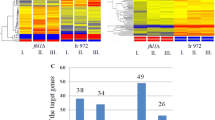Summary
Schizosaccharomyces pombe initiates sexual development in response to nutritional starvation. The level of cAMP inS. pombe cells changed during the transition from exponential growth to stationary phase. It also changed in response to a shift from nitrogen-rich medium to nitrogen-free medium. A decrease of approximately 50% was observed in either case, suggesting thatS. pombe cells contain less cAMP when they initiate sexual development.S. pombe cells that expressed the catalytic domain ofSaccharomyces cerevisiae adenylyl cyclase from theS. pombe adh1 promoter contained 5 times as much cAMP as the wild type and could not initiate mating and meiosis. These observations, together with previous findings that exogenously added cAMP inhibits mating and meiosis and that cells with little cAMP are highly derepressed for sexual development, strongly suggest that cAMP functions as a key regulator of sexual development inS. pombe. Thepde1 gene, which encodes a protein homologous toS. cerevisiae cAMP phosphodiesterase I, was isolated as a multicopy suppressor of the sterility caused by a high cAMP level. Disruption ofpde1 madeS. pombe cells partially sterile and meiosis-deficient, indicating that this cAMP phosphodiesterase plays an important role in balancing the cAMP level in vivo.
Similar content being viewed by others
References
Beach D, Piper M, Nurse P (1982) Construction of aSchizosaccharomyces pombe gene bank in a yeast bacterial shuttle vector and its use to isolate genes by complementation. Mol Gen Genet 187:326–329
Beach D, Rodgers L, Gould J (1985)RAN1 + controls the transition from mitotic division to meiosis in fission yeast. Curr Genet 10:297–311
Calleja GB, Johnson BF, Yoo BY (1980) Macromolecular changes and commitment to sporulation in the fission yeastSchizosaccharomyces pombe. Plant Cell Physiol 21: 613–624
Egel R, Egel-Mitani M (1974) Premeiotic DNA synthesis in fission yeast. Exp Cell Res 88:127–134
Fukui Y, Kozasa T, Kaziro Y, Takeda T, Yamamoto M (1986) Role of a ras homolog in the life cycle ofSchizosaccharomyces pombe. Cell 44:329–336
Grimm C, Kohli J, Murray J, Maundrell K (1988) Genetic engineering ofSchizosaccharomyces pombe: A system for gene disruption and replacement using theura4 gene as a selectable marker. Mol Gen Genet 215:81–86
Gutz H, Heslot H, Leupold U, Loprieno N (1974)Schizosaccharomyces pombe. In: King RD (ed) Handbook of genetics, vol 1. Plenum Publishing, New York, pp 395–446
Henikoff S (1984) Unidirectional digestion with exonuclease III creates targeted breakpoints for DNA sequencing. Gene 28:351–359
Hoffman CS, Winston F (1991) Glucose repression of transcription of theSchizosaccharomyces pombe fbp1 gene occurs by a CAMP signaling pathway. Genes Dev 5:561–571
Kataoka T, Broek D, Wigler M (1985) DNA sequence and characterization of theS. cerevisiae gene encoding adenylate cyclase. Cell 43:493–505
Kawamukai M, Ferguson K, Wigler M, Young D (1991) Genetic and biochemical analysis of the adenylyl cyclase ofSchizosaccharomyces pombe. Cell Regul 2:155–164
Kikuchi Y, Kitazawa Y, Shimatake H, Yamamoto M (1988) The primary structure of theleu1 + gene ofSchizosaccharomyces pombe. Curr Genet 14:375–379
Kuo JF, Krueger BK, Sanes JR, Greengard P (1970) Cyclic nucleotide-dependent protein kinases. V. Preparation and properties of adenosine 3′,5′-monophosphate-dependent protein kinase from various bovine tissues. Biochim Biophys Acta 212:79–91
Lacombe M-L, Podgorski GL, Franke J, Kessin RH (1986) Molecular cloning and developmental expression of the cyclic nucleotide phosphodiesterase gene ofDictyostelium discoideum. J Biol Chem 261:16811–16817
Lowry OH, Rosebrough NJ, Farr AL, Randall RJ (1951) Protein measurement with a phenol reagent. J Biol Chem 193:265–275
Maeda T, Mochizuki N, Yamamoto M (1990) Adenylyl cyclase is dispensable for vegetative cell growth in the fission yeastSchizosaccharomyces pombe. Proc Natl Acad Sci USA 87:7814–7818
Miyamoto E, Kuo JF, Greengard P (1969) Cyclic nucleotide-dependent protein kinases. III. Purification and properties of adenosine 3′,5′-monophosphate-dependent protein kinase from bovine brain. J Biol Chem 244:6395–6402
Mullis KB, Faloona FA (1987) Specific synthesis of DNAin vitro via a polymerase-catalyzed chain reaction. Methods Enzymol 155:335–350
Nikawa J, Cameron S, Toda T, Ferguson KM, Wigler M (1987a) Rigorous feedback control of CAMP levels inSaccharomyces cerevisiae. Genes Dev 1:931–937
Nikawa J, Sass P, Wigler M (1987b) The cloning and characterization of the low affinity cAMP phosphodiesterase gene ofS. cerevisiae. Mol Cell Biol 7:3629–3636
Rothstein R (1983) One-step gene disruption in yeast. Methods Enzymol 101:202–211
Russell P (1989) Gene cloning and expression in fission yeast. In: Nasim A, Young P, Johnson BF (eds) Molecular biology of the fission yeast. Academic Press, New York, pp 243–271
Russell PR, Hall BD (1983) The primary structure of the alcohol dehydrogenase gene from the fission yeastSchizosaccharomyces pombe. J Biol Chem 258:143–149
Sanger F, Nicklen S, Coulson AR (1977) DNA sequencing with chain-terminating inhibitors. Proc Natl Acad Sci USA 74:5463–5467
Sass P, Field J, Nikawa J, Toda T, Wigler M (1986) Cloning and characterization of the high affinity cAMP phosphodiesterase ofS. cerevisiae. Proc Natl Acad Sci USA 83:9303–9307
Sherman F, Fink G, Hicks J (1986) Methods in yeast genetics: Laboratory course manual. Cold Spring Harbor Laboratory Press, Cold Spring Harbor, New York
Southern EM (1975) Detection of specific sequences among fragments separated by gel electrophoresis. J Mol Biol 98:503–517
Toda T, Uno I, Ishikawa T, Powers S, Kataoka T, Broek D, Cameron S, Broach J, Matsumoto K, Wigler M (1985) In yeast, RAS proteins are controlling elements of adenylate cyclase. Cell 40:27–36
Watanabe Y, Iino Y, Furuhata K, Shimoda C, Yamamoto M (1988) TheS. pombe mei2 gene encoding a crucial molecule for commitment to meiosis is under the regulation of cAMP. EMBO J 7:761–767
Wilson RB, Tatchell K (1988)SRA5 encodes the low-Km cyclic AMP phosphodiesterase ofSaccharomyces cerevisiae. Mol Cell Biol 8:505–510
Yamawaki-Kataoka Y, Tamaoki T, Choe H-R, Tanaka H, Kataoka T (1989) Adenylate cyclase in yeast: A comparison of the genesSchizosaccharomyces pombe andSaccharomyces cerevisiae. Proc Natl Acad Sci USA 86:5693–5697
Young D, Riggs M, Field J, Vojtek A, Broek D, Wigler M (1989) The adenylyl cyclase gene fromSchizosaccharomyces pombe. Proc Natl Acad Sci USA 86:7989–7993
Author information
Authors and Affiliations
Additional information
Communicated by K. Isono
Rights and permissions
About this article
Cite this article
Mochizuki, N., Yamamoto, M. Reduction in the intracellular cAMP level triggers initiation of sexual development in fission yeast. Molec. Gen. Genet. 233, 17–24 (1992). https://doi.org/10.1007/BF00587556
Received:
Issue Date:
DOI: https://doi.org/10.1007/BF00587556




